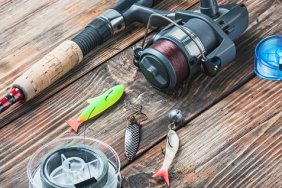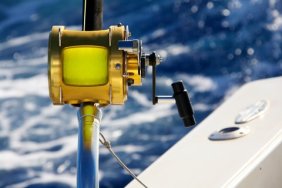 There are a few must-have bass lures that anglers need to keep on-hand at all times. Jigs happen to be one such lure, due to its effectiveness and versatility in a variety of situations throughout the seasons. It’s a great cold weather lure for fall and winter, and today we’ll take a look at a few ways you can use it during these colder seasons.
There are a few must-have bass lures that anglers need to keep on-hand at all times. Jigs happen to be one such lure, due to its effectiveness and versatility in a variety of situations throughout the seasons. It’s a great cold weather lure for fall and winter, and today we’ll take a look at a few ways you can use it during these colder seasons.
Swimming a jig is a popular tactic for colder times of the year. As aquatic vegetation dies and cold fronts move in, bass tend to hold deeper in the submerged grass, looking upward for bait. By swimming a jig just above the grass, any bass holding in the grass will rise and take the swimming jig. This jig also works well if the water’s clear and you can see holes in the grass. Here, you can swim the jig and then drop it into those holes with a dip of your rod tip. This tactic is useful at the edge of weeds, too.
I like to work jigs slowly along the bottom when the weather’s colder, crawling them, in a sense. This enables the jig to imitate a crawfish moving slowly across the bottom, which gives the presentation of an easy meal. Points on main river channels tend to be productive in the fall. Bass tend to congregate on these points all year and with a jig you can determine the water depth where the bass are holding by casting it to the shallow side of the point, reeling it down, and letting it fall off the lip of the break. Also, most points have brush piles that you can work by casting the jig past and crawling it around the base of them, as well as stumps, logs, and other structure. Where rocks, brush piles, and other structure are found, though, you’ll find that a football head jig will become stuck less often than a round jighead.
Lastly, while it may be less familiar to some anglers, a shaky head jig can be a great asset when the temperatures drop. Its design allows you to let it sit motionless on the bottom and then, with a little shake of the rod tip, you can use the slack line to case the worm to dance on the bottom. This finesse presentation plays on the lethargic nature of bass during the fall and winter, as they’ll be less enthusiastic about expending precious energy to chase food. Perhaps the biggest advantage of using a shaky head jig is that, unlike the majority of other lures, it stays within the strike zone longer and offers an enticing presentation.
There are several tactics that anglers can employ during the colder months of the year to entice bass to strike when their biology makes them less apt to, and jigs are right up there at the top of the list. Today’s tips will help you use them to their fullest potential should you be inclined to hit the lake during the fall and winter.








